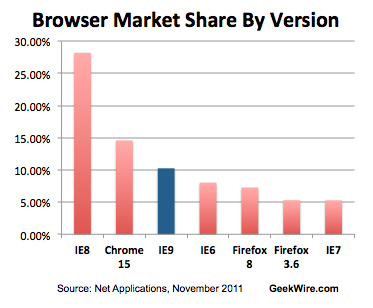 Microsoft plans to streamline the way Internet Explorer is upgraded through its Windows Update process, aiming to move more PC users to the latest version of its web browser, even if they don’t actively decide to make the upgrade.
Microsoft plans to streamline the way Internet Explorer is upgraded through its Windows Update process, aiming to move more PC users to the latest version of its web browser, even if they don’t actively decide to make the upgrade.
Updates to Internet Explorer are already distributed to users who have opted to receive important updates through the Windows Update feature inside the Microsoft operating system. However, unlike security updates, the process with Internet Explorer today isn’t completely automatic. Users see an additional dialog box that requires them to take additional steps to launch the IE installer.
Under the new plan, Microsoft will eliminate that extra dialog box, essentially making the process more automatic. Ryan Gavin, a general manager on Microsoft’s Internet Explorer team, said in an interview that the company’s internal telemetry shows that users are often confused by the extra steps and end up not installing the new browser even though they’ve opted to receive automatic updates.
“This is really our attempt to help push the web forward,” said Gavin, citing the better security and performance of Internet Explorer 9, and noting that web developers will benefit from having more users on browsers that support the latest in HTML5 and other web standards.
In particular, the company has been making a big push to get users to upgrade from Internet Explorer 6, originally released more than a decade ago.
 Microsoft is walking a fine line as it changes the auto update process, with the potential to reignite the debate over whether it’s appropriate to distribute new versions of Internet Explorer through Windows Update at all. Rivals such as Google Chrome and Mozilla Firefox have their own updating processes, but they don’t have the advantage of being included in the auto update mechanism for the dominant PC operating system.
Microsoft is walking a fine line as it changes the auto update process, with the potential to reignite the debate over whether it’s appropriate to distribute new versions of Internet Explorer through Windows Update at all. Rivals such as Google Chrome and Mozilla Firefox have their own updating processes, but they don’t have the advantage of being included in the auto update mechanism for the dominant PC operating system.
The company has traditionally contended that Internet Explorer should be considered a component of Windows, not a standalone program.
Microsoft will still give companies a mechanism to block the automatic browser updates, and it also promises not to automatically update Internet Explorer for customers who have declined installations of IE9 or IE8 in the past. Users will be able to uninstall the update to return to a previous version. Options such as home page, search provider and default browser won’t be changed.
The new updates will apply to users of Windows XP, Windows Vista and Windows 7, starting in January in Australia and Brazil. The company says it plans to gradually roll out the changes elsewhere in the world based on customer feedback from those initial deployments.
More details in this post today on the Microsoft’s Exploring IE blog.



